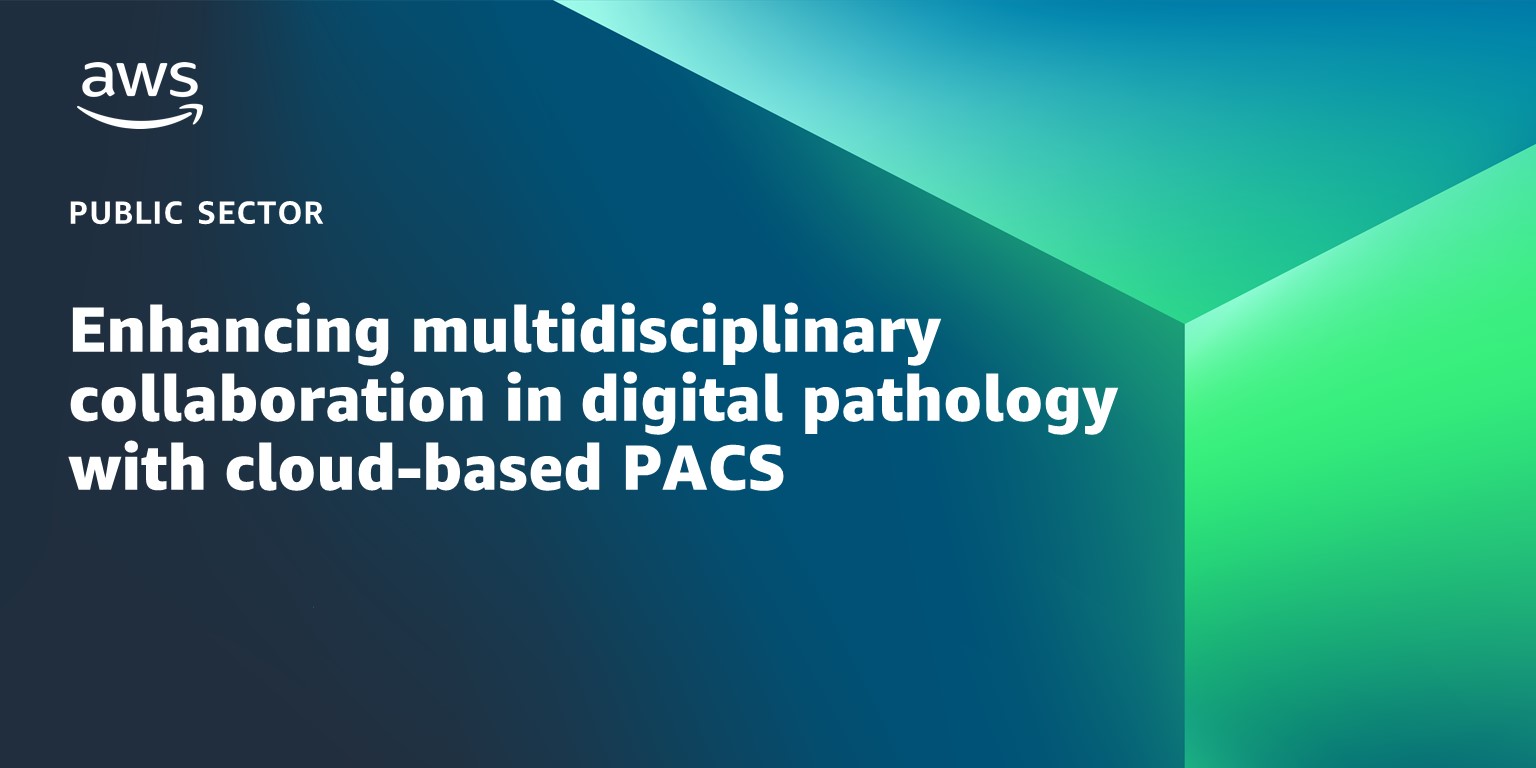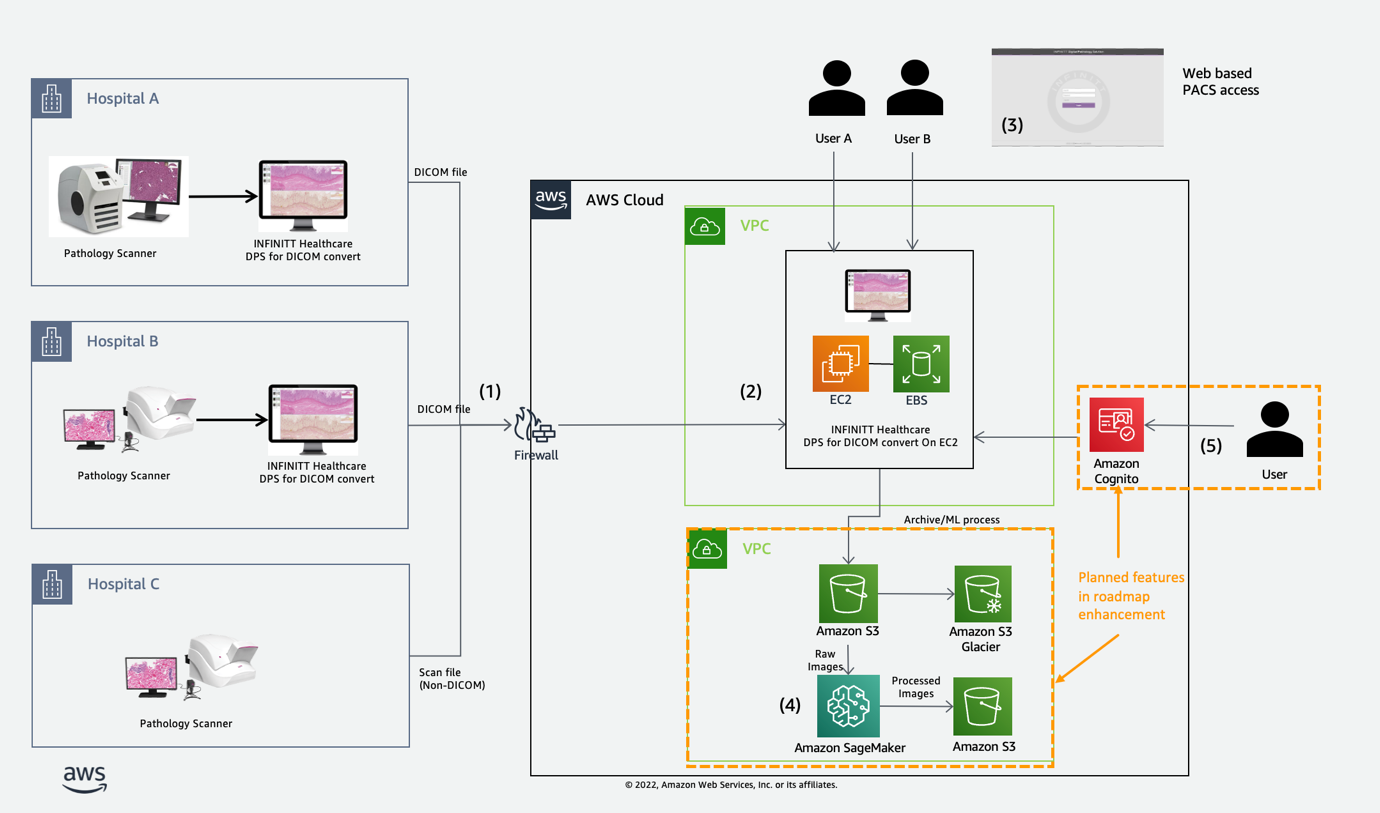AWS Public Sector Blog
Enhancing multidisciplinary collaboration in digital pathology with cloud-based PACS

Pathologists use the frozen section procedure to help analyze biopsied tissue. Frozen section traditionally relies exclusively on microscopy for tissue biopsy visualization. However, this poses significant problems with information sharing and data storage because microscopy slides are fragile, and the dye used to visualize the cell structure fades over time. The invention of microscopy-mounted cameras simplified slide capture. Still, the images are often compressed to optimize for local storage and the added manual work of capturing the images while generating a report can detract from a pathologist’s typical workflow.
Although whole-slide scanners have eased the burden of image capture and sparked initial interest in digital pathology, they aren’t a complete end-to-end solution. Many hospitals worldwide have yet to fully leverage the full potential of digital pathology.
INFINITT Healthcare, a healthcare technology (HealthTech) company based in South Korea, is working to change that by extracting and transforming whole-slide imaging (WSI) output as a Digital Imaging and Communications in Medicine (DICOM) file—a digital version of WSI that is helping pathologists save time and resources, streamline multidisciplinary communication, and accelerate time to solutions in patient care. This is then stored in their cloud-based digital pathology system (DPS) which is built on Amazon Web Services (AWS).
Digital pathology pilot research initiative
Samsung Medical Center (SMC), one of Seoul’s premier hospitals with a dedicated oncology center, is leading the way in digital pathology adoption. SMC sees over two million patients annually and is a tertiary hospital staffed by approximately 7,400 staff, including 1,200 doctors and 2,300 nurses. In a joint research initiative with INFINITT, SMC piloted a cloud-native picture archiving and communication system (PACS) in its pathology department in 2019.
SMC’s pathology department supports a caseload of 52,000 per year, which averages to about 214 patients per day. Pathologists sit in a separate building away from the main hospital block. Typically, biopsy specimens need to be transported by porters, processed and prepped by the lab technicians for microscopic examination, and finally interpreted by pathologists. Any urgent findings are communicated over the phone with the primary team doctors.
Immediate benefits of digitalization in pathology
In the past, pathologists would analyze biopsy slides and write their findings in a report separately in a clinical note. If they wanted to discuss the findings during a tumor board, they needed to capture a microscopic image with a microscopy-connected camera and prepare a PowerPoint file that includes histopathologic findings. Additionally, if the biopsy slides are broken, then the pathologist must request a re-cut of paraffin block to get the same slide images.
By digitalizing the whole slide, pathologists can now annotate their findings directly on the images. Subsequently, the images can be opened directly on the INFINITT DPS during the tumor board, saving time and effort, as well as allowing for a more informed decision focusing on patient care.
The cloud-based DPS immediately improved communication in multidisciplinary oncology teams. Pathologists can call the primary care team and review WSI together using the software system provided by INFINITT. As a bidirectional consultation tool, through the newest screen-sharing technology on web browsers, a group of pathologists from multiple remote areas can see the whole slide images together simultaneously and diagnose them together. This is all possible because each participant can move the slide and point out certain positions with their own mouse cursor, and everyone else can see it all in real-time.
The DPS has been implemented in some medical centers in the Asia Pacific region to enable research collaborations at the national level. The Korean Society of Pathologists subsequently adopted the DPS for their member’s education and training purposes.
The consensus across the board in the pathologist community is that the new DPS mitigated the need for costly local IT infrastructure and improved data governance. Research data retention policy used to be difficult to implement at scale. Server racks had to be disposed by a third-party vendor to comply with policy. With the cloud-based DPS, the data retention policy is written into the Amazon Simple Storage Service (Amazon S3) bucket and backed up automatically.
How INIFITT uses AWS to digitalize WSI

Figure 1. Architectural diagram of INFINITT’s solution that helped support SMC.
INFINITT uses multiple AWS services in their DPS software. Figure 1 illustrates the high-level architecture of the solution:
1) WSIs in the DICOM format from various academic institutions are exported and stored in Amazon Elastic Block Store (Amazon EBS) in an Amazon Virtual Private Cloud (Amazon VPC).
2) INFINITT DPS is hosted on an Amazon Elastic Compute Cloud (Amazon EC2) instance in a VPC.
3) Users access the WSI studies via a web portal.
4) Annotated WSI images are stored in Amazon S3. Amazon SageMaker is used to manage the entire artificial intelligence (AI) and machine learning (ML) workflow and train models on a specific disease of interest. Then, the processed images are stored in Amazon S3 and can be accessed via INFINITT DPS.
5) Amazon Cognito will be added in the INFINITT DPS roadmap to support secure access to the data with differentiating roles, such as clinical researchers and enhancing access governance.
INFINITT’s DPS solution helps pathologists enhance communication and multidisciplinary collaboration; plus, hospital systems see a 50-70% savings when switching from traditional IT infrastructure to cloud-based PACS. DPS supports automatic backup of WSI data and also helps ease data retention policy governance.
What’s next for digital pathology?
Generally, WSI output varies between 2.5 gigabytes (GB) to 10 GB of uncompressed images. A typical workload in a clinical pathology lab can be about 1,000 images per day, accounting for 10 terabytes (TB) of data generated daily. WSI studies can be in the magnitude of GBs; this is in contrast to other specialties, such as radiology, where the average size of a digital imaging study is usually tens or hundreds of megabytes (MBs).
As the entire SMC pathology department moves toward using 100% WSI, a cloud-based DPS can be much more cost-efficient in the long-term. With slide digitalization, SMC plans to innovate further and experiment with Amazon SageMaker. SMC intends to build AI and ML algorithms that can accelerate the detection of pathological findings on WSI. Moreover, they hope to automate the tedious grading process required for breast and prostate cancer to ease the burden of the clinical workload on the pathologists.
Pathology as a profession is experiencing a shortage of staffing due to a global aging workforce. However, cancer diagnoses are rising. Therefore, digital transformation in pathology is integral for hospitals to continue functioning optimally in the decades to come. A cloud-native approach can help support staff and patient outcomes without placing additional capital and operational burden on hospital information systems.
Learn more about AWS for healthcare
Healthcare and life science organizations around the world are reinventing how they collaborate, make data-driven clinical and operational decisions, enable precision medicine, and decrease the cost of care. To help healthcare and life science organizations achieve business and technical goals, AWS for Health provides an offering of AWS services and AWS Partner solutions, used by thousands of customers globally. For more information about how AWS assists in critical healthcare missions around the globe, visit the AWS for healthcare hub, or contact the AWS Public Sector Team.
Read related stories on the AWS Public Sector Blog:
- Large scale AI in digital pathology without the heavy lifting
- Automating clinical lab workflow at scale for chronic disease monitoring with the cloud
- Alzheimer’s disease research portal enables data sharing and scientific discovery at scale
- Designing a biometric IoMT solution to support health equity with AWS ProServe
- AMILI helps advance precision medicine by building microbiome library on AWS
- Transforming radiology workflows with clinical decision support powered by AWS
Subscribe to the AWS Public Sector Blog newsletter to get the latest in AWS tools, solutions, and innovations from the public sector delivered to your inbox, or contact us.
Please take a few minutes to share insights regarding your experience with the AWS Public Sector Blog in this survey, and we’ll use feedback from the survey to create more content aligned with the preferences of our readers.